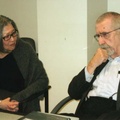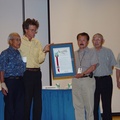It was not until her mother died that Satsuki Ina came to understand the historic event that deeply affected her family—a part of World War II history that has been long suppressed within the Japanese American community.
“My mother had it all set up for me when she left me that box,” Satsuki Ina said of the small metal box she found at her deceased mother’s home. “I was stunned by what she described.”

Emmy Award night. Left to right: Satsuki Ina, Producer/Screen Writer/Co-Director, Emery Clay III, Director of Photography, and Kim Ina, Associate Producer. Director Stephen Holsapple unable to attend.
From that box emerged the little-known story of Japanese American resistance to their wartime II incarceration as told in Ina’s new film, From a Silk Cocoon, that premiered at the San Francisco Asian American film festival March 2005. Ina, a Sansei, was born in Tule Lake and raised in San Francisco. She built a career as a college professor and a psychotherapist in Sacramento before embarking on a creative new path as a filmmaker, first with Children of the Camps, about the psychic damage of the incarceration, and now From a Silk Cocoon.
From a Silk Cocoon shatters the “model minority” myth that Japanese Americans passively went into camps and that there were no protests or resistance to the incarceration.
“They didn’t all go quietly,” says Ina. “It was a false story, but that was the story then. That was the public face Japanese America and the JACL chose to show to the outside world.”
The story of Ina’s parents’ decision to protest the injustice of the loyalty questionnaire is told through the letters written between her parents—a wrenching narrative that illuminates what happened to people who refused to answer “yes-yes” and, in consequence, were removed to the maximum high-security Tule Lake Segregation Center. The context of her family’s story is the untold tale of protest and resistance by Japanese Americans imprisoned in America’s concentration camps.
From a Silk Cocoon is also the first major examination of the mass renunciations of U.S. citizenship, which, as researchers are finding, was a massive violation of civil rights—a racial denationalization program administered by the Department of Justice that was shrouded in secrecy for over 50 years.
Protest and Resistance
In Topaz, Ina’s father, Itaru Ina, gave a three-sentence speech protesting the infamous Loyalty Questionnaire that led to the loyalty/disloyalty, yes-yes/no-no paradigm that divided the Japanese American community. “He even used the words ‘our Constitutional rights’ for which he was charged with sedition,” said Ina.
“It was all there in his FBI file,” says Ina, shivering with revulsion. “Someone at that meeting was taking notes on everything he said.”
For exercising his right to speak out, Ina’s father was removed once again, this time to the Tule Lake Segregation Center. Tule Lake was the prison where those who refused to comply with the government demand to state unconditional loyalty were sent.
As the Segregation Center, Tule Lake in 1943 was populated with the most articulate dissident leaders and organizers from the other WRA camps. As might be expected, they demanded better working and living conditions at the mismanaged, overcrowded Center, which was soon wracked with work stoppages, strikes and demonstrations. The administration relied on inmate police to control activities within the Center, a failure because the inmates felt pressure not to report fellow inmates. Tule Lake became a lawless, overcrowded ghetto—a breeding ground for fear and conflict and anger—fueled by the injustice of the incarceration.
Within this context of repression and hopelessness Itaru and his wife Shizuko were forced to confront their family’s uncertain future. Believing that their children had no future in a country that did not want them, they decided to renounce their U.S. citizenship.

Satsuki Ina and her brother Kiyoshi Ina in front of the barrack at the DOJ camp in Bismarck, ND where their father, Itaru Ina was interned following his renunciation at Tule Lake.
Congress passed the Renunciation law and President Roosevelt signed it into law on July 1, 1944, marking one of the saddest and least known chapters of Japanese American history. The denationalization law was directed at Japanese Americans in Tule Lake and authored by U.S. Attorney General Francis Biddle, and enabled American citizens to renounce U.S. citizenship during time of war. Stripped of U.S. citizenship, the renunciants became enemy aliens, thus simplifying the plan to deport them at the war’s end. Initially, only 17 persons applied to renounce their citizenship. Ultimately, 5,461 American citizens, 70% of all adult U.S. citizens at Tule Lake, renounced their citizenship. Most of those who renounced remained in the U.S. as “Native American aliens” stripped of their citizenship; and 1,327 former U.S. citizens were expatriated to a defeated and war-torn Japan.
Most of those who renounced realized soon after that renouncing was a mistake, but found that it was not as simple to regain what had so easily been taken. The JACL and the National ACLU refused to support the renunciants cause. National ACLU Director Roger Baldwin even pressured the Northern California Chapter of the ACLU to withdraw support.
“Had there been an organized voice, it would have given the issue so much more credibility,” said Ina. As it was, with no standing, no platform, they were silenced, she says. “No one wanted to hear them say, I renounced because it was wrong what they did to us.”
“No one championed their story except Wayne Collins,” says Ina. “Not the JACL, not the ACLU—no one except this lone white guy.”
Shame and Silencing
Why, given the extraordinary circumstances at the Tule Lake Segregation Center, would anyone who renounced feel shame for an act done to protect their family, to control their circumstances, or even as a form of protest?
“The source of shame is so complex. There are multiple layers of shame. To be accused of being the enemy, then being imprisoned. Even if you’re innocent, you still feel shame for that,” she says, comparing it to a rape victim’s feeling of being sullied.
The dominant post-war position of the JACL helped shape the definition of those who actively cooperated with the government as “good” and those who resisted as “bad.” The story of loyalty at all costs came with a high price to those who renounced—they were made to feel they must suppress their story to present a unified “public face” of the Japanese American community, says Ina.
A half a century later, the JACL-fostered myth of a uniformly patriotic and eagerly cooperative Japanese American community continues to marginalize those who made a different choice. Sadly, most renunciants internalized the message that they did something wrong.
“They even call themselves ‘disloyal’ even though they feel this deep sense of injustice,” says Ina.
These were powerless victims who were made to feel their protests were disloyal, and that their alleged disloyalty was hurting other Japanese Americans, she said. The perceived need was to present a unified picture of loyalty and patriotism, emphasizing the dedication and sacrifice of the 442nd. “Anyone who told a different story was blamed for delaying release and acceptance.”
Finally, the story of the renunciants at Tule Lake is beginning to be told. “Reparations made it safe to talk about it, and opened the door to telling the story about JA resistance,” she says.

In May 2006, "From a Silk Cocoon" received an Emmy Award from the Northern California chapter of the National Academy of Television Arts and Sciences, in the Historical/Cultural Program category. Here is a photo of Satsuki Ina accepting her award.
Reflecting on her parents’ renunciations, “I sensed the shame,” Ina said. “But, the really sad part was the fear.” She vividly recalled her parents trying to discourage her from speaking out and being identified as a protester while she was a student at Berkeley during the 60s.
Haunted by the trauma her parents were swept up in after they spoke out, they warned fearfully, “Terrible things will happen.”
Itaru Ina spent the rest of his life striving to prove he was a good American. He even stopped going to Buddhist Church, his daughter speculates, to avoid over-identification with things Japanese, and became deeply involved in Boy Scouts in the San Francisco Nikkei community.
“He devoted years showing his loyalty though the Boy Scouts,” says Ina. “But despite the years of compensatory acts, he remained anxious and mistrustful of the government.
“There was always that knowledge, that at a flip of a switch, they could be demonized, the house turned upside down, they could go through your things, take your radio, your freedom... I think they lived with that fear always.”
*This article was originally published in the Nichi Bei Times on March 15, 2005.
© 2005 Barbara Takei





